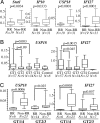Interferon signaling and treatment outcome in chronic hepatitis C
- PMID: 18467494
- PMCID: PMC2383932
- DOI: 10.1073/pnas.0707882105
Interferon signaling and treatment outcome in chronic hepatitis C
Abstract
Hepatitis C virus (HCV) infection is a major cause of chronic liver disease worldwide. The current standard therapy for chronic hepatitis C (CHC) consists of a combination of pegylated IFN alpha (pegIFNalpha) and ribavirin. It achieves a sustained viral clearance in only 50-60% of patients. To learn more about molecular mechanisms underlying treatment failure, we investigated IFN-induced signaling in paired liver biopsies collected from CHC patients before and after administration of pegIFNalpha. In patients with a rapid virological response to treatment, pegIFNalpha induced a strong up-regulation of IFN-stimulated genes (ISGs). As shown previously, nonresponders had high expression levels of ISGs before therapy. Analysis of posttreatment biopsies of these patients revealed that pegIFNalpha did not induce expression of ISGs above the pretreatment levels. In accordance with ISG expression data, phosphorylation, DNA binding, and nuclear localization of STAT1 indicated that the IFN signaling pathway in nonresponsive patients is preactivated and refractory to further stimulation. Some features characteristic of nonresponders were more accentuated in patients infected with HCV genotypes 1 and 4 compared with genotypes 2 and 3, providing a possible explanation for the poor response of the former group to therapy. Taken together with previous findings, our data support the concept that activation of the endogenous IFN system in CHC not only is ineffective in clearing the infection but also may impede the response to therapy, most likely by inducing a refractory state of the IFN signaling pathway.
Conflict of interest statement
The authors declare no conflict of interest.
Figures




Comment in
-
A fresh look at interferon-alpha signaling and treatment outcomes in chronic hepatitis C.Hepatology. 2008 Oct;48(4):1330-3. doi: 10.1002/hep.22571. Hepatology. 2008. PMID: 18821612
References
-
- Meylan E, Tschopp J. Toll-like receptors and RNA helicases: Two parallel ways to trigger antiviral responses. Mol Cell. 2006;22:561–569. - PubMed
-
- Gale M, Jr, Foy EM. Evasion of intracellular host defence by hepatitis C virus. Nature. 2005;436:939–945. - PubMed
-
- Strader DB, Wright T, Thomas DL, Seeff LB. Diagnosis, management, and treatment of hepatitis C. Hepatology. 2004;39:1147–1171. - PubMed
-
- Hadziyannis SJ, et al. Peginterferon-alpha2a and ribavirin combination therapy in chronic hepatitis C: A randomized study of treatment duration and ribavirin dose. Ann Intern Med. 2004;140:346–355. - PubMed
-
- Fried MW, et al. Peginterferon alfa-2a plus ribavirin for chronic hepatitis C virus infection. N Engl J Med. 2002;347:975–982. - PubMed
Publication types
MeSH terms
Substances
Associated data
- Actions
LinkOut - more resources
Full Text Sources
Other Literature Sources
Molecular Biology Databases
Research Materials
Miscellaneous

